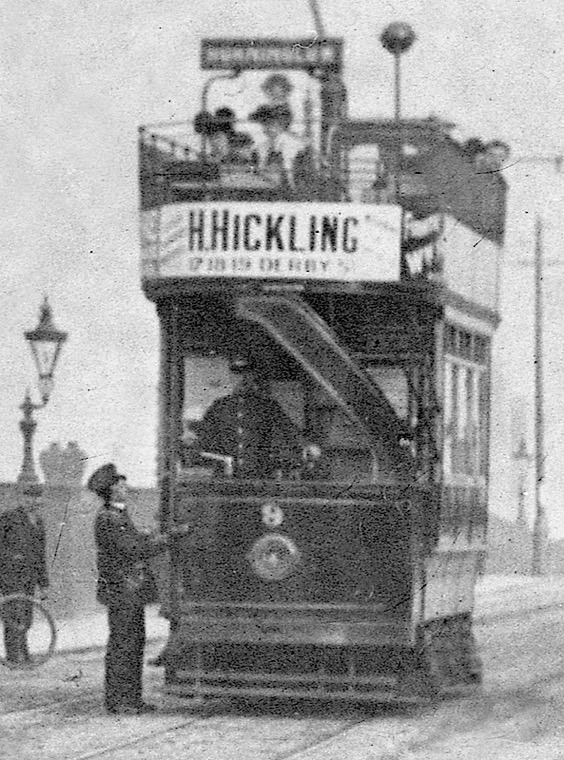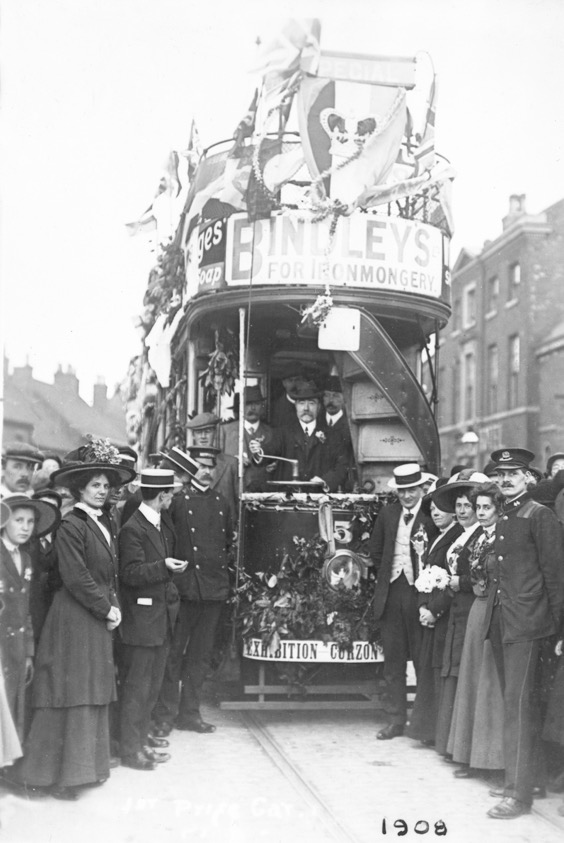Burton-upon-Trent Corporation Tramways
History
Burton's 3ft 6ins-gauge overhead electric tramway, which was owned and operated by Burton-upon-Trent Corporation, commenced public services on the 3rd August 1903.
Although not built until almost four years into the Twentieth Century, there had actually been regular proposals to build a horse tramway within the town since 1879; these had, however, been resisted by the corporation, possibly due to the narrow streets and the sheer number of level crossings, of which there were a staggering 32 by 1890. More applications were submitted to the corporation in the 1890s, but all met the same fate as the earlier schemes, including one in 1897, following which the council publicly remarked that if tramways were to be built in the town, then it would be the council that would operate them.
Having stymied the plans of private enterprise for the best part of 20 years, the council finally decided (in March 1899) that it should actively look into the matter, but then proceeded at such a leisurely pace — taking 16 months to produce a report — that it came in for heavy criticism in the local press. This appears to have had the desired effect, the council deciding on the 23rd July 1900 to proceed with the construction of a municipal tramway system, powers duly being acquired in April 1901. The council then, however, reverted to type, construction work not starting until the autumn of 1902, with the tramway still not being fully finished when opened.
The system seems to have been fairly prosperous in its early years, the corporation responding to the needs of the public by commencing a top-covering programme in 1904, which was to see 15 of the 20-strong tramcar fleet dealt with by 1915/16.
A second tramway came to the town on the 13th June 1906, when services commenced on the Midland Railway's newly built Burton and Ashby Light Railway. The B&ALR's cars operated over the corporation's tracks between Winshill — where the B&ALR tracks met those of the BCT — and a terminal stub in Wellington Street in the centre of town, the corporation receiving payment per car mile plus electricity costs.
Unusually for a provincial town, the BCT system was largely double track throughout, though on the down side, it had to traverse the maze of railway lines and sidings serving the town's major industry (brewing) a total of eight times. The system, which totalled 6.66 route miles, comprised a central spine running southeastwards from the Town Hall, along Station Street to its junction with High Street, with four lines radiating from it. From the western end of Station Street, a line ran northwards via Waterloo Street, Victoria Crescent and Horninglow Road North to a terminus in Horninglow outside St John's Church. At the eastern end of Station Street, lines ran: southwestwards along High Street to Branston, as well as northeastwards, before turning southeastwards over the river via Bridge Street and Burton Bridge. On the far bank of the Trent, the tracks immediately divided, one line running southwards to Stapenhill, and the other making the steep ascent up Bearwood Hill Road to Winshill. Just before the terminus, which was situated outside St Mark's Church, a lined branch off up High Bank Road to the borough boundary, where it met the tracks of the B&ALR; although corporation-owned, the BCT never operated a service over it. An additional line served the depot, running via Guild Street and Horninglow Street, in so doing creating an alternative route between Station Street and Bridge Street.
By 1910, the tramway was giving cause for concern as passenger numbers were declining, while the costs were high, chiefly track renewals and tramcar axle failures, the latter breaking at the quite staggering rate of one to two per week, this being attributed to the level crossings. From here on in, the system endured a long, slow decline, not helped by the Great War, the undertaking quickly losing men (and their skills) to the armed forces, with maintenance being reduced as a consequence. The situation was further exacerbated by a shortage of spares and government restrictions on the procurement of new materials and/or tramcars, the tramway emerging from the conflict in badly run-down condition.
The corporation never seems to have been particularly happy with its tramway, it had been very slow off the mark in building one, and though it held powers for extensions, these were never acted on, the inevitable result being that several areas of the town were not served by the system. By 1916, the council was already looking at alternatives to tramway extensions, acquiring provisional powers to operate motorbuses, though these were not used for the time being. Despite having clearly entertained the idea of expanding operations using motorbuses, following the Great War the corporation proceeded to buy 4 new tramcars. However, no sooner had these arrived (in 1920), than the council once again turned its thoughts to motorbus operation, obtaining a provisional order in 1921, but once again failing to take the next step (service introduction). By 1924, however, matters had become more pressing, with various districts clamouring for a public transport service, the corporation's first motorbus service finally running on the 1st May 1924.
Although the initial results were disappointing, the corporation persisted, new buses being steadily acquired throughout the 1920s and new services being introduced. The bus was now very much in the ascendent, both in the town and outside it, the first major tramway casualty being the B&ALR, which as a long, rural tramway was particularly susceptible to motorbus competition. The B&ALR ceased operations on the 19th February 1927, though it did not apparently remember to inform Burton Council until several days later!
Although no formal decision had been made to abandon the corporation tramway, the deliberate introduction of motorbus services that either directly competed with, or even replaced tramway services, left most people in no doubt that the tramway's days were numbered. Tramway abandonment was kicked back and forth between the full council and the Tramways Committee throughout late 1928 and early 1929, a decision finally being taken in favour of motorbuses (over trolleybuses). Further tramway services were withdrawn during the year — the undertaking formally changing name in August to Burton Corporation Transport — and the last tram of all running on the 31st December 1929.
Uniforms
The photographic record for Burton-upon-Trent Corporation Tramways is sparse indeed, and images of staff are extremely rare, so what follows can therefore only be regarded as a tentative description, which may well change as and when further material comes to light.
Conductors and motormen were issued with single-breasted jackets with five buttons (bearing the municipal shield and full system title — see link), two waist-level pockets (slit opening) and stand-up collars; the latter bore an employee number on the bearer's left-hand side (in individual brass numerals) and system initials — 'B C T' — on the right-hand side (in individual brass letters). Caps were of the tensioned-crown peaked type; they bore a brass cap badge comprising the municipal shield (topped by a crown) within a wreath, seated upon a ribbon containing the full system title ('BURTON-ON-TRENT CORPORATION TRAMWAYS') with another ribbon beneath containing the municipal motto ('HONOR ALIT ARTES'). A standard, off-the-shelf, script-lettering grade badge was worn beneath the main cap badge, either 'Conductor' or 'Motorman', though the latter awaits photographic confirmation. Conductors' uniforms certainly changed at some point, and though still single-breasted with stand-up collars, they now bore tow breast pockets and epaulettes; the latter, along with the collars and pocket closure flaps, were all piped. It is likely that a change was also made to the style of motormen's jackets too, probably to double-breasted, lancer-style tunics.
Although the badges and buttons were almost certainly brass, examples of nickel cap badges have survived, suggesting that a switch may have been made to this material at some point.
Tramcar crews were also issued with long, double-breasted greatcoats with high, fold-over collars; it is unclear whether the latter carried any insignia.
Inspectors wore typical tramway inspector garb, i.e., single-breasted jackets with hidden buttons (or more likely a hook and eye affair) and stand-up collars, all edged in a finer material than the main body of the jacket; the collars probably bore 'Inspector' in embroidered script lettering on both sides. Headgear was initially the drooping-peak cap (with a pompom on top); the cap probably bore the grade — 'Inspector' — in embroidered script lettering on a hat band, though this cannot be made out with certainty on the surviving photographs. It is likely that the cap — at least — was changed to a more modern design in later years, though confirmation must await the discovery of new photographic evidence.
Burton-upon-Trent Corporation Tramways employed the services of female employees during the Great War — both as conductresses and motorwomen — to replace male staff lost to the armed services. Photographic evidence is, however, yet to come to light, so the style of uniform worn remains, for the moment, unknown.
Further reading
For a short pictorial history of the tramway, see: 'Trams and buses in Burton, 1903-1985' by D Stanier, K West and L Stanier; Carlton Publishing (1991).
Images
Motormen and conductors
What would appear to be a brand-new Tramcar No 1 (with No 9 behind), captured on Station Bridge, and thus dating the photograph to 1903. No less than three inspectors are in the picture. With thanks to the National Tramway Museum. 
An enlargement of the above photograph showing the crew of Tramcar No 9. The motorman is clearly wearing a single-breasted jacket.
A flagged and bedecked Tramcar No 5 on the occasion of a Royal visit in 1908. With thanks to the National Tramway Museum. 
An enlargement of the above photograph showing the conductor, Employee No 44. He is wearing an elaborate 'tramways' cap badge, above an off-the-shel', script-lettering grade badge.
Burton-upon-Trent Corporation Tramways cap badge — brass. Author's Collection.
Standard off the shelf script-lettering cap badges of the type used by Burton-upon-Trent Corporation Tramways — brass. Author's Collection.
Another enlargement of the above photograph, this time showing a figure who is probably the motorman. His collar badge — individual 'B C T' letters — is easily made out, though the situation with his cap badge is much less clear.
A studio portrait of a Burton-upon-Trent Corporation Tramways conductor (Employee No 39) — photo undated, but probably taken around the time of the Great War. Unlike the earlier uniforms, the jacket bears epaulettes, which along with the collars and pocket flaps, are piped. Source unknown. 
The crew of Tramcar No 19 pose for the cameraman in Branston Road in 1908. Both men are wearing long, double-breasted greatcoats with high, fold-over collars. With thanks to the National Tramway Museum. 
Burton-upon-Trent Corporation Tramways cap badge — nickel. Author's Collection.
Senior staff
An enlargement of the 1903 photograph above of Tramcar No 1 showing an inspector in his 'pom pom'-topped drooping-peak cap.